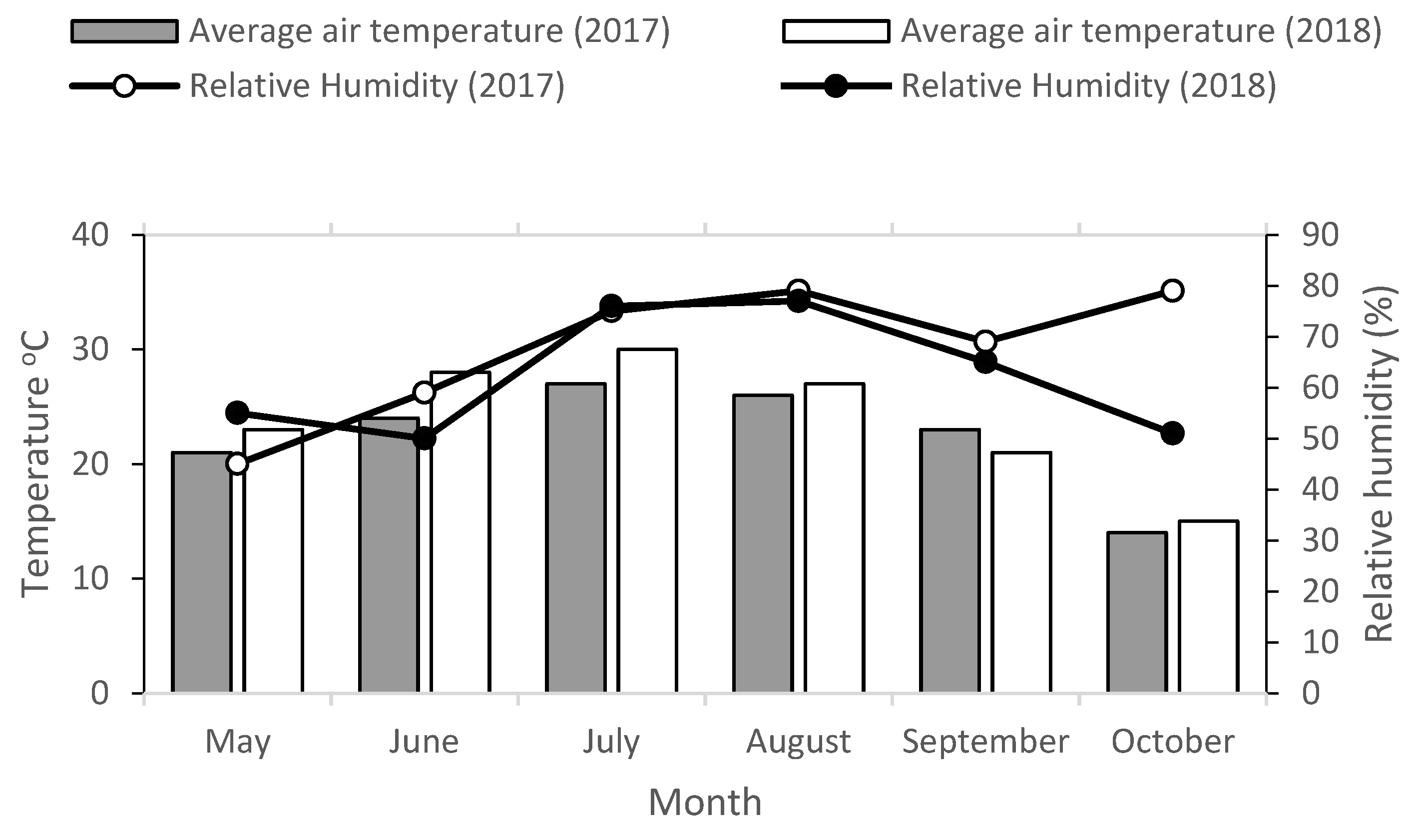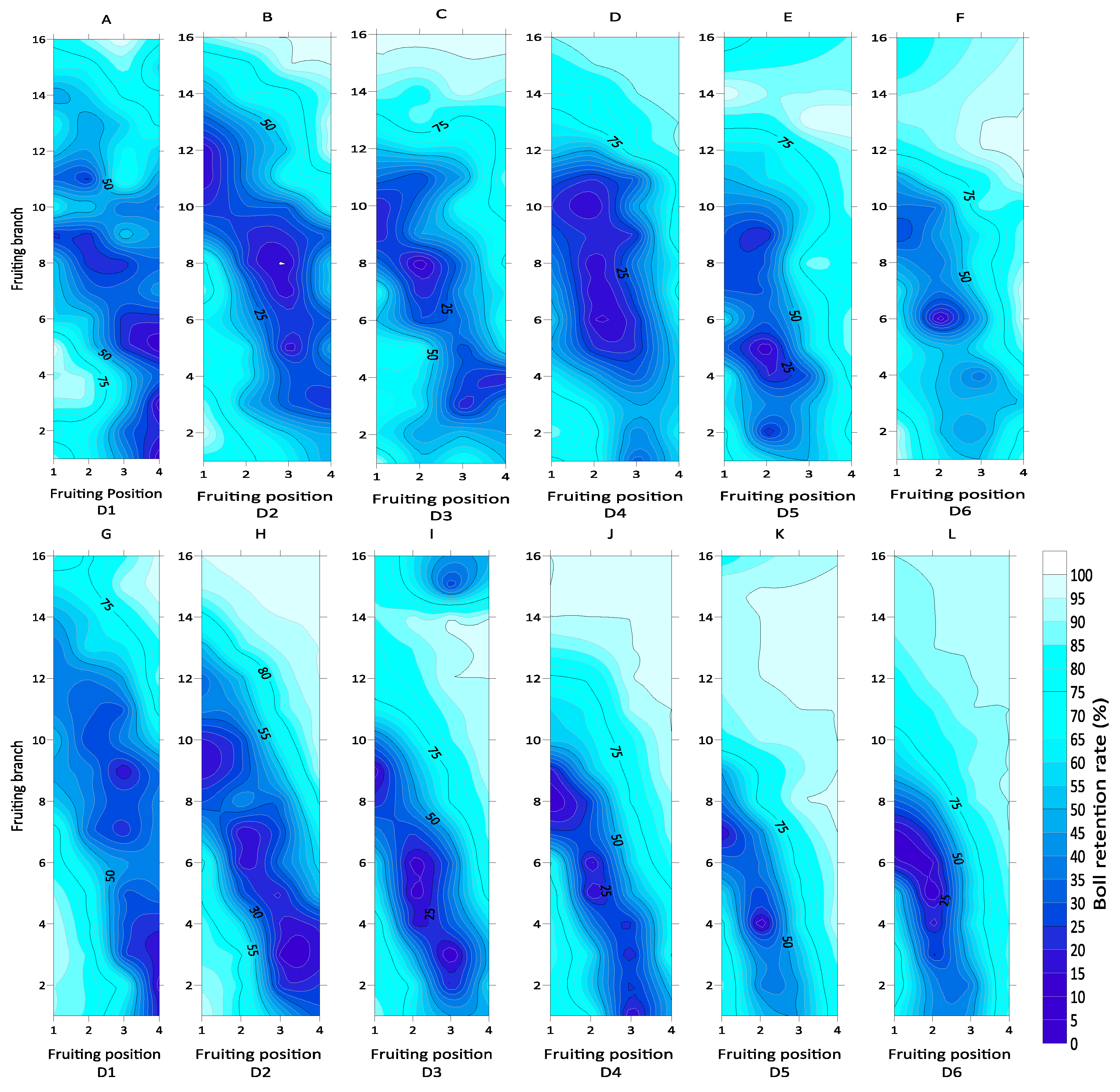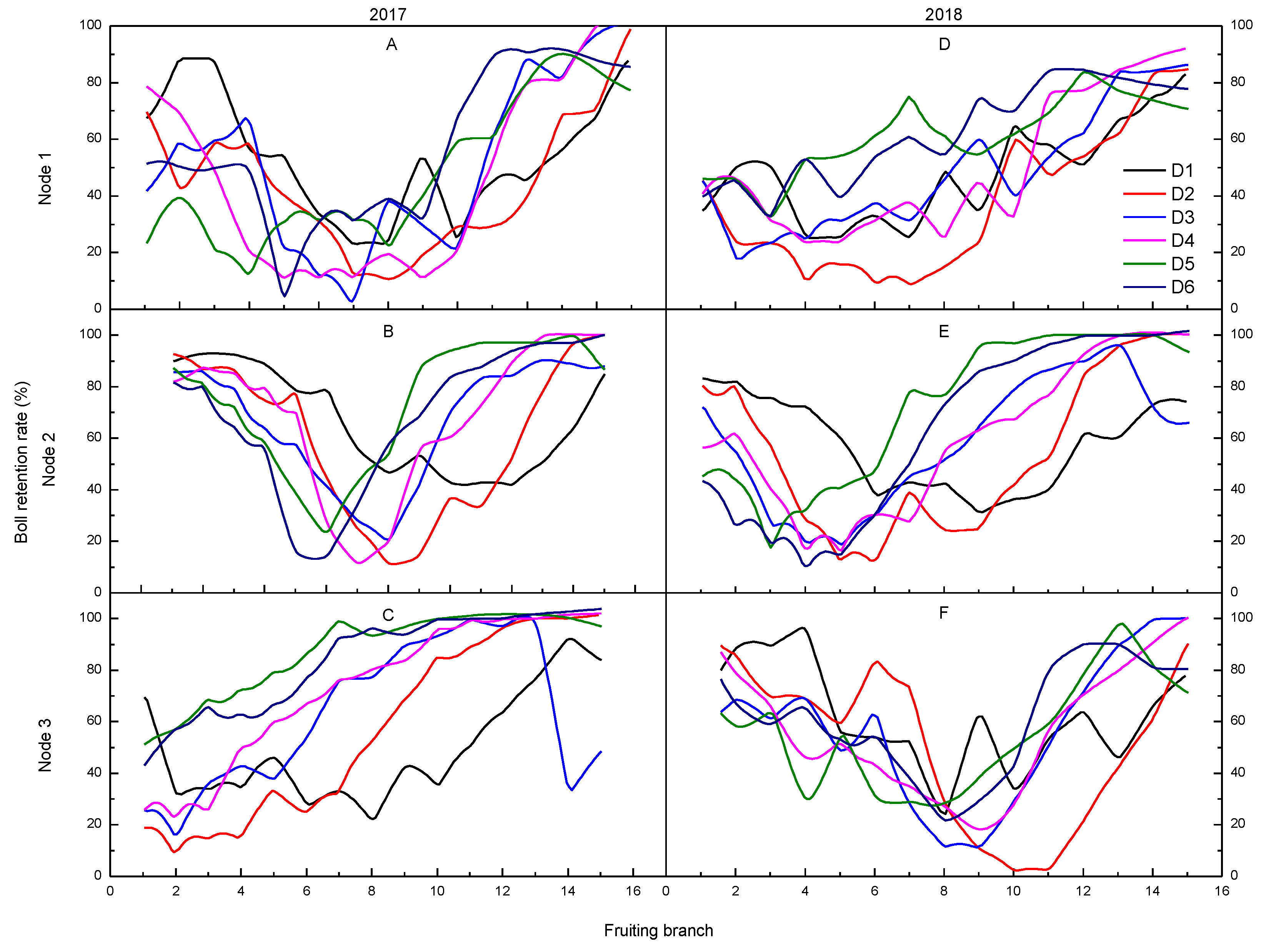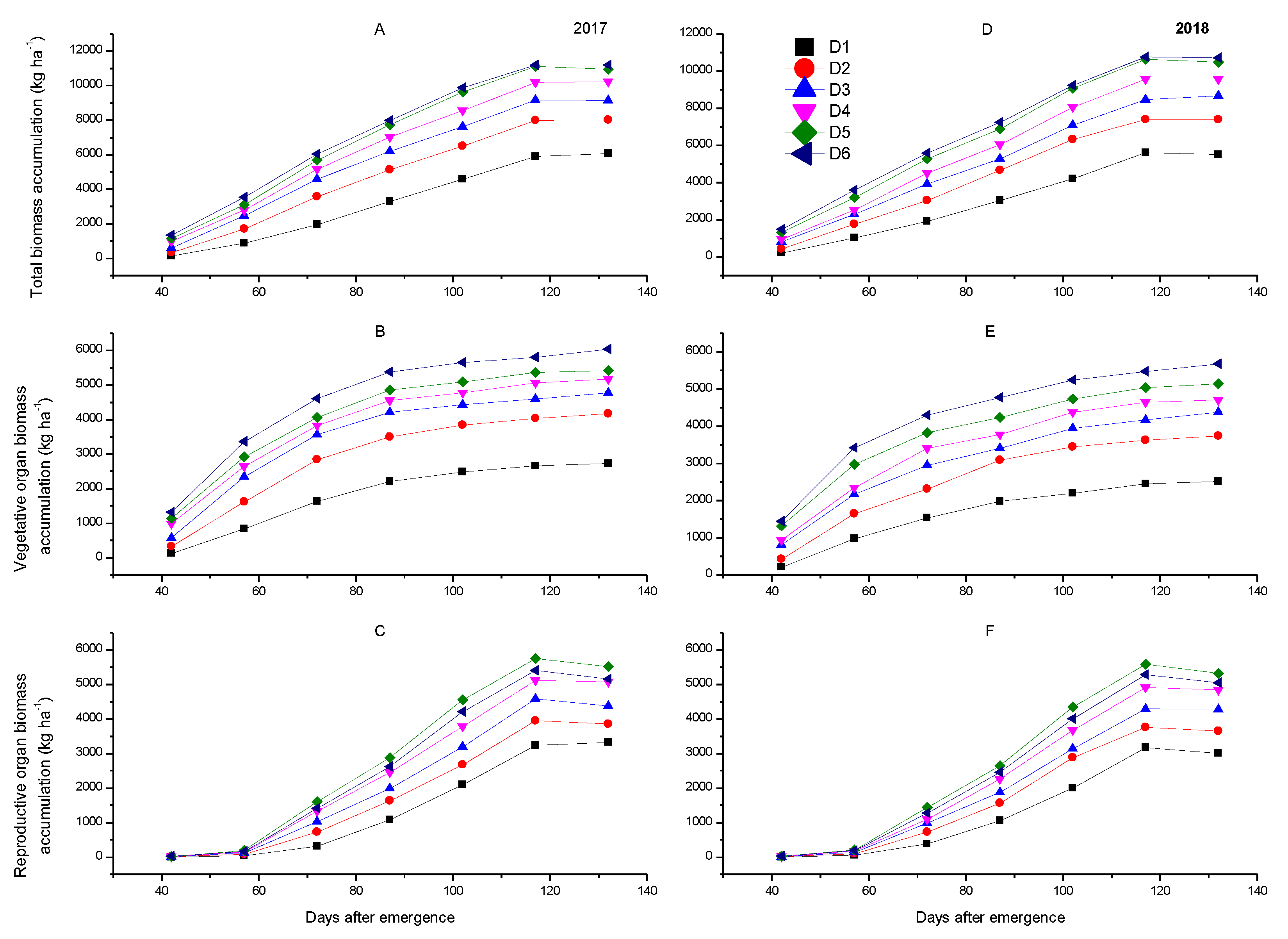Plant Density Influences Reproductive Growth, Lint Yield and Boll Spatial Distribution of Cotton
Abstract
1. Introduction
2. Materials and Methods
2.1. Experimental Site
2.2. Experimental Design
2.3. Observations
2.3.1. Cotton Phenology
2.3.2. Cotton Plant Growth Parameters
2.3.3. Yield and Yield Components
2.3.4. Biomass Accumulation
2.3.5. Data Analysis
3. Results
3.1. Cotton Growth Stages
3.2. Cotton Growth Parameters
3.3. Yield and Yield Components
3.4. Cotton Plant Biomass (CPB) Accumulation
3.5. Simulation of Biomass Accumulation
4. Discussion
5. Conclusions
Author Contributions
Funding
Acknowledgments
Conflicts of Interest
References
- Maiti, R.; Satya, P.; Rajkumar, D.; Ramaswamy, A. Crop Plant Anatomy; CABI: Wallingford, UK, 2012; Volume 42, ISBN 9781780640198. [Google Scholar]
- Statista Distribution of Global Cotton Production by Country. Available online: https://www.statista.com/statistics/595561/distribution-of-global-cotton-production-by-country/ (accessed on 31 March 2019).
- Dai, J.; Dong, H. Intensive cotton farming technologies in China: Achievements, challenges and countermeasures. Field Crops Res. 2014, 155, 99–110. [Google Scholar] [CrossRef]
- Abdurakhmonov, I.Y. Role of genomic studies in boosting yield. In Proceedings of the International Cotton Advisory Board (ICAC), Cartagena, Colombia, 20 September–4 October 2013; pp. 7–22. [Google Scholar]
- Zhang, Y.; Dong, H. Yield and Fiber Quality of Cotton; Elsevier Inc: Amsterdam, The Netherlands, 2019; pp. 1–9. [Google Scholar]
- Ajayakumar, M.Y.; Umesh, M.R.; Shivaleela, S.; Nidagundi, J.M. Light interception and yield response of cotton varieties to high density planting and fertilizers in sub-tropical India. J. Appl. Nat. Sci. 2018, 9, 1835–1839. [Google Scholar] [CrossRef]
- Venugopalan, M.V.; Kranthi, K.R.; Blaise, D.; Lakde, S.; Sankaranarayana, K. High density planting system in cotton—The Brazil experience and Indian initiatives. Cott. Res. J. 2014, 5, 1–7. [Google Scholar]
- Zhi, X.Y.; Han, Y.C.; Li, Y.B.; Wang, G.P.; Du, W.L.; Li, X.X.; Mao, S.C.; Lu, F. Effects of plant density on cotton yield components and quality. J. Integr. Agric. 2016, 15, 1469–1479. [Google Scholar] [CrossRef]
- Yang, G.Z.; Luo, X.J.; Nie, Y.C.; Zhang, X.L. Effects of plant density on yield and canopy micro environment in hybrid cotton. J. Integr. Agric. 2014, 13, 2154–2163. [Google Scholar] [CrossRef]
- Bednarz, C.W.; Nichols, R.L.; Brown, S.M. Plant density modifications of cotton within-boll yield components. Crop Sci. 2006, 46, 2076–2080. [Google Scholar] [CrossRef]
- Dong, H.; Li, W.; Eneji, A.E.; Zhang, D. Nitrogen rate and plant density effects on yield and late-season leaf senescence of cotton raised on a saline field. Field Crops Res. 2012, 126, 137–144. [Google Scholar] [CrossRef]
- Mccarty, J.C.; Wu, J.; Jenkins, J.N. Genetic association of cotton yield with its component traits in derived primitive accessions crossed by elite upland cultivars using the conditional ADAA genetic model. Euphytica 2008, 161, 337–352. [Google Scholar] [CrossRef]
- Worley, S.; Culp, T.W.; Harrell, D.C.; Region, S. The relative contributions of yield components to lint yield of upland cotton, Gossypium hirsutum. Euphytica 1974, 23, 399–403. [Google Scholar] [CrossRef]
- Clement, J.D.; Constable, G.A.; Liu, S.M. Increasing cotton seed fibre density as a breeding strategy to improve fibre fineness. Field Crops Res. 2014, 160, 81–89. [Google Scholar] [CrossRef]
- Imran, M.; Shakeel, A.; Azhar, F.M.; Farooq, J.; Saleem, M.F.; Saeed, A. Combining ability analysis for within-boll yield components in upland cotton (Gossypium hirsutum L.). Genet. Mol. Res. 2012, 11, 2790–2800. [Google Scholar] [CrossRef] [PubMed]
- Khan, A.; Najeeb, U.; Wang, L.; Tan, D.K.Y.; Yang, G.; Munsif, F.; Ali, S.; Hafeez, A. Planting density and sowing date strongly influence growth and lint yield of cotton crops. Field Crops Res. 2017, 209, 129–135. [Google Scholar] [CrossRef]
- Bednarz, C.W.; Bridges, D.C.; Brown, S.M. Analysis of cotton yield stability across population densities. Agron. J. 2000, 92, 128–135. [Google Scholar] [CrossRef]
- Boquet, D.J.; Moser, E.B. Boll retention and boll size among intrasympodial fruiting sites in cotton. Crop Sci. 2003, 43, 195–201. [Google Scholar] [CrossRef]
- Ehlig, C.F.; Lemert, R.D. Effects of fruit load, temperature, and relative humidity on boll retention of cotton. Crop Sci. 1973, 13, 1971–1974. [Google Scholar] [CrossRef]
- Guinn, G. Fruiting of cotton. III. Nutritional stress and cutout. Crop Sci. 1985, 25, 981–985. [Google Scholar] [CrossRef]
- Reddy, K.R.; Hodges, H.F.; Reddy, V.R. Temperature Effects on cotton fruit retention. Agron. J. 1992, 84, 26–30. [Google Scholar] [CrossRef]
- Bange, M.P.; Milroy, S.P. Growth and dry matter partitioning of diverse cotton genotypes. Field Crops Res. 2004, 87, 73–87. [Google Scholar] [CrossRef]
- Khan, A.; Wang, L.; Ali, S.; Tung, S.A.; Hafeez, A.; Yang, G. Optimal planting density and sowing date can improve cotton yield by maintaining reproductive organ biomass and enhancing potassium uptake. Field Crops Res. 2017, 214, 164–174. [Google Scholar] [CrossRef]
- Xia, Y.Q. A probe into planting density for cotton high yielding. Xinjiang Agric. Sci. 2008, 45, 70–71. [Google Scholar]
- Dong, H.; Li, Z.; Tang, W.; Zhang, D. Evaluation of a production system in china that uses reduced plant densities and retention of vegetation branches. J. Cotton Sci. 2005, 9, 1–9. [Google Scholar]
- Dong, H.Z.; Li, W.J.; Tang, W.; Li, Z.H.; Zhang, D.M. Crop/Stress physiology effects of genotypes and plant density on yield, yield components and photosynthesis in BT transgenic cotton. J. Agron. Crop Sci. 2006, 139, 132–139. [Google Scholar] [CrossRef]
- Dong, H.; Li, W.; Tang, W.; Li, Z.; Zhang, D.; Niu, Y. Yield, quality and leaf senescence of cotton grown at varying planting dates and plant densities in the Yellow River Valley of China. Field Crops Res. 2006, 98, 106–115. [Google Scholar] [CrossRef]
- Wang, R.Q.; Pang, C.Q. Effect of NPK fertilizer and density on cotton lint yield. China Cott. 2009, 36, 8–12. [Google Scholar]
- Ali, M.; Ali, L.; Sattar, M. Response of seed cotton yield to various plant populations and planting methods. J. Agric. Res. 2010, 48, 163–169. [Google Scholar]
- Wei, H.; Meili, C.; Wenqing, Z.; Binglin, C.; Youhua, W.; Shan-shan, W.; Yali, M.; Zhiguo, Z. The effects of sowing date on cottonseed properties at different fruiting-branch positions. J. Integr. Agric. 2017, 16, 1322–1330. [Google Scholar]
- Clawson, E.L.; Cothren, J.T.; Blouin, D.C. Nitrogen fertilization and yield of cotton in ultra-narrow and conventional row spacings. Agron. J. 2006, 98, 72–79. [Google Scholar] [CrossRef]
- Gwathmey, C.O.; Clement, J.D. Field crops research alteration of cotton source—sink relations with plant population density and mepiquat chloride. Field Crops Res. 2010, 116, 101–107. [Google Scholar] [CrossRef]
- Siebert, J.; Stewart, A. Influence of plant density on cotton response to mepiquat chloride application. Agron. J. 2006, 98, 1634–1639. [Google Scholar] [CrossRef]
- Yang, G.Z.; Zhou, M.Y. Multi-location investigation of optimum planting density and boll distribution of high-yielding cotton (G. hirsutum L.) in Hubei Province, China. Agric. Sci. China 2010, 9, 1749–1757. [Google Scholar] [CrossRef]
- Mao, L.; Zhang, L.; Evers, J.B.; van der Werf, W.; Liu, S.; Zhang, S.; Wang, B.; Li, Z. Yield components and quality of intercropped cotton in response to mepiquat chloride and plant density. Field Crops Res. 2015, 179, 63–71. [Google Scholar] [CrossRef]
- Dong, H.; Kong, X.; Li, W.; Tang, W.; Zhang, D. Effects of plant density and nitrogen and potassium fertilization on cotton yield and uptake of major nutrients in two fields with varying fertility. Field Crops Res. 2010, 119, 106–113. [Google Scholar] [CrossRef]
- Davidonis, G.H.; Johnson, A.S.; Landivar, J.A.; Fernandez, C.J. Cotton fiber quality is related to boll location and planting date. Agron. J. 2004, 96, 42–47. [Google Scholar] [CrossRef]
- Blaise, D. Yield, boll distribution and fibre quality of hybrid cotton (Gossypium hirsutum L.) as influenced by organic and modern methods of cultivation. J. Agron. Crop Sci. 2006, 192, 248–256. [Google Scholar] [CrossRef]
- Zhao, D.; Oosterhuis, D. Cotton responses to shade at different growth stages: Growth, lint yield and fibre quality. Exp. Agric. 2000, 36, 27–39. [Google Scholar] [CrossRef]
- Pettigrew, W.T. Moisture deficit effects on cotton lint yield, yield components, and boll distribution. Agron. J. 2004, 2, 377–383. [Google Scholar] [CrossRef]
- Xue, H.; Han, Y.; Li, Y.; Wang, G.; Feng, L.; Fan, Z.; Du, W.; Yanga, B.; Cao, C.; Maoa, S. Spatial distribution of light interception by different plant population densities and its relationship with yield. Field Crops Res. J. 2015, 184, 17–27. [Google Scholar] [CrossRef]
- Khan, A.; Kong, X.; Najeeb, U.; Zheng, J.; Kean, D.; Tan, Y.; Akhtar, K.; Munsif, F.; Zhou, R. Planting density induced changes in cotton biomass yield, fiber quality, and phosphorus distribution under beta growth model. Agronomy 2019, 9, 500. [Google Scholar] [CrossRef]
- Villalobos, F.J.; Sadras, V.O.; Fereres, E. Plant density and competition. In Principles of Agronomy for Sustainable Agriculture; Springer: Berlin, Germany, 2016; pp. 159–168. ISBN 9783319461168. [Google Scholar]
- Mao, L.; Zhang, L.; Zhao, X.; Liu, S.; van der Werf, W.; Zhang, S.; Spiertz, H.; Li, Z. Crop growth, light utilization and yield of relay intercropped cotton as affected by plant density and a plant growth regulator. Field Crops Res. 2014, 155, 67–76. [Google Scholar] [CrossRef]





| Treatment | Growth Stages m-d/DAE | Growing Period/Day | ||||||||
|---|---|---|---|---|---|---|---|---|---|---|
| Emergence | Seedling | Squaring | Flowering | Boll Opening | Seedling | Squaring | Flowering | Boll Opening | Total | |
| Year 2017 | ||||||||||
| Plant Density (PD) | ||||||||||
| D1 | 5–1/0 | 5–17/16 | 5–31/30 | 6–29/59 | 8–17/108 | 16a | 14b | 29b | 49c | 117c |
| D2 | 5–1/0 | 5–17/16 | 5–31/30 | 6–29/59 | 8–17/108 | 16a | 14b | 29b | 49c | 117c |
| D3 | 5–1/0 | 5–17/16 | 5–31/30 | 6–29/59 | 8–17/108 | 16a | 14b | 29b | 49c | 117c |
| D4 | 5–1/0 | 5–17/16 | 5–31/30 | 6–29/59 | 8–17/108 | 16a | 14b | 29b | 49c | 117c |
| D5 | 5–1/0 | 5–17/16 | 5–31/30 | 6–29/59 | 8–19/110 | 16a | 14b | 29b | 51b | 119b |
| D6 | 5–1/0 | 5–17/16 | 6–01/31 | 7–01/61 | 8–23/114 | 16a | 15a | 30a | 53a | 122a |
| Probability | – | – | – | – | – | ns | ns | ns | *** | *** |
| Year 2018 | ||||||||||
| Plant Density (PD) | ||||||||||
| D1 | 4–28/0 | 5–17/19 | 5–29/29 | 6–24/55 | 8–6/98 | 19a | 10c | 26c | 43c | 106d |
| D2 | 4–28/0 | 5–17/19 | 5–30/30 | 6–25/56 | 8–8/100 | 19a | 11b | 27b | 45b | 110c |
| D3 | 4–28/0 | 5–17/19 | 5–30/30 | 6–25/56 | 8–8/100 | 19a | 11b | 27b | 45b | 110c |
| D4 | 4–28/0 | 5–17/19 | 5–30/30 | 6–25/56 | 8–10/102 | 19a | 11b | 27b | 47a | 112b |
| D5 | 4–28/0 | 5–17/19 | 5–30/30 | 6–25/56 | 8–10/102 | 19a | 11b | 27b | 47a | 112b |
| D6 | 4–28/0 | 5–17/19 | 5–31/31 | 6–27/58 | 8–13/104 | 19a | 12a | 28a | 48a | 116a |
| Probability | – | – | – | – | – | ns | ** | ** | *** | *** |
| Treatment | Plant Height (cm) | Fruiting Branch/m2 | Fruiting Nodes/m2 | Leaves/Plant | Shedding % |
|---|---|---|---|---|---|
| Year 2017 | |||||
| Plant Density (PD) | |||||
| D1 | 96.2a | 21.5f | 120.9d | 20.2a | 49.8c |
| D2 | 94.5ab | 45.7e | 143.9d | 19.2ab | 50.5c |
| D3 | 93.2ab | 59.1d | 179.9c | 18.8bc | 52.7bc |
| D4 | 90.9b | 75.6c | 195.5bc | 17.7cd | 55.5b |
| D5 | 87.3c | 86.9b | 223.9ab | 17.4d | 52.4bc |
| D6 | 85.6c | 110a | 245.8a | 17.3d | 60.8a |
| Probability | *** | *** | *** | *** | ** |
| Year 2018 | |||||
| Plant Density (PD) | |||||
| D1 | 94.5ab | 22.5e | 116.8f | 19.7a | 50.2d |
| D2 | 92.4a | 43.4d | 137.2e | 18.3ab | 52.9cd |
| D3 | 91.2ab | 55.4cd | 176.8d | 18.2abc | 55.2bc |
| D4 | 88.1bc | 71.27bc | 191.8c | 17bcd | 57.9b |
| D5 | 85.3cd | 81.4b | 219.5b | 16.3cd | 54.3bc |
| D6 | 84.4d | 106.4a | 243.5a | 16d | 62.2a |
| Probability | *** | *** | *** | ** | *** |
| Treatment | Boll (m2) | Boll Weight (g) | Seed Cotton Yield (kg ha−1) | Lint Yield (kg ha−1) | Lint Percentage (%) |
|---|---|---|---|---|---|
| Year 2017 | |||||
| Plant Density (PD) | |||||
| D1 | 66.6e | 6a | 3010d | 1319.8d | 43.9a |
| D2 | 71.2d | 6a | 3240.5d | 1390.8cd | 43.1a |
| D3 | 79.6c | 5.9a | 3717.6c | 1462.8c | 39.4ab |
| D4 | 84.5b | 5.9a | 4089.2b | 1576.1b | 38.5b |
| D5 | 95.8a | 5.7ab | 4545.5a | 1682.9a | 37.1b |
| D6 | 86.5b | 5.6b | 4054.6b | 1493.3bc | 36.8b |
| Probability | *** | ns | *** | *** | * |
| Year 2018 | |||||
| Plant Density (PD) | |||||
| D1 | 63.3d | 5.9a | 2730.9d | 1185.5c | 43.6a |
| D2 | 69.5cd | 5.8ab | 3080.5cd | 1249.8bc | 41.3a |
| D3 | 75.1bc | 5.8ab | 3369.3bc | 1291bc | 38.4a |
| D4 | 83.9ab | 5.8ab | 3679.5b | 1369.4b | 37.3a |
| D5 | 93.3a | 5.6ab | 4232.2a | 1545a | 36.5a |
| D6 | 85.2a | 5.3b | 3682.2b | 1316.8bc | 35.8a |
| Probability | *** | ns | ** | ** | ns |
| Items. | Treatment | Regression Equation | R2 |
|---|---|---|---|
| Cotton plant Biomass (2017) | D1 | Y = 6489.58539/(1 + 258.80173e−0.06442t) | 0.9936 *** |
| D2 | Y = 8384.97677/(1 + 150.02704e−0.06353t) | 0.9886 *** | |
| D3 | Y = 9513.24778/(1 + 103.58321e−0.06163t) | 0.9857 *** | |
| D4 | Y = 10,702.15904/(1 + 83.38416e−0.05897t) | 0.9918 *** | |
| D5 | Y = 11,449.4722/(1 + 95.96235e−0.06213t) | 0.9936 *** | |
| D6 | Y = 11,654.22062/(1 + 74.52064e−0.05987t) | 0.9938 *** | |
| Vegetative organ biomass | D1 | Y = 2688.34078/(1 + 327.97186e−0.08594t) | 0.9911 *** |
| D2 | Y = 4044.963/(1 + 299.20571e−0.0908t) | 0.9883 *** | |
| D3 | Y = 4600.03731/(1 + 292.16952e−0.0975t) | 0.9855 *** | |
| D4 | Y = 5059.78581/(1 + 101.2047e−0.08053t) | 0.9898 *** | |
| D5 | Y = 5349.42745/(1 + 88.38862e−0.07954t) | 0.9911 *** | |
| D6 | Y = 5863.81961/(1 + 97.73689e−0.08321t) | 0.9889 *** | |
| Reproductive organ biomass | D1 | Y = 3540.71667/(1 + 8858.027e−0.09421t) | 0.9938 *** |
| D2 | Y = 4156.21378/(1 + 2397.25191e−0.08411t) | 0.9861 *** | |
| D3 | Y = 4733.72286/(1 + 1661.90033e−0.08182t) | 0.9825 *** | |
| D4 | Y = 5390.69518/(1 + 1186.04395e−0.07956t) | 0.9877 *** | |
| D5 | Y = 5829.68693/(1 + 1712.22879e−0.08643t) | 0.9870 *** | |
| D6 | Y = 5481.00173/(1 + 1929.64913e−0.08696t) | 0.9867 *** | |
| Cotton plant Biomass (2018) | D1 | Y = 6091.05095/(1 + 170.71673e−0.05978t) | 0.9852 *** |
| D2 | Y = 7845.41809/(1 + 147.36714e−0.0629t) | 0.9932 *** | |
| D3 | Y = 9360.03681/(1 + 68.7009e−0.05305t) | 0.9916 *** | |
| D4 | Y = 10,258.05161/(1 + 78.27322e−0.05585t) | 0.9910 *** | |
| D5 | Y = 11,305.05257/(1 + 59.00724e−0.05377t) | 0.9888 *** | |
| D6 | Y = 11,491.06419/(1 + 47.71984e−0.05211t) | 0.9893 *** | |
| Vegetative organ biomass | D1 | Y = 2479.89431/(1 + 113.23746e−0.07191t) | 0.9790 *** |
| D2 | Y = 3709.78204/(1 + 95.81778e−0.0718t) | 0.9811 *** | |
| D3 | Y = 4307.53685/(1 + 40.98259e−0.06163t) | 0.9721 *** | |
| D4 | Y = 4673.23384/(1 + 51.90518e−0.06702t) | 0.9785 *** | |
| D5 | Y = 5054.68733/(1 + 34.5008e−0.06467t) | 0.9704 *** | |
| D6 | Y = 5489.17354/(1 + 46.69089e−0.0721t) | 0.9683 *** | |
| Reproductive organ biomass | D1 | Y = 3258.29804/(1 + 9103.86586e−0.09606t) | 0.9830 *** |
| D2 | Y = 3867.94729/(1 + 4789.94074e−0.09413t) | 0.9924 *** | |
| D3 | Y = 4566.99271/(1 + 1635.38226e−0.08157t) | 0.9902 *** | |
| D4 | Y = 5126.04201/(1 + 1923.88057e−0.0846t) | 0.9919 *** | |
| D5 | Y = 5676.07015/(1 + 1900.81286e−0.08647t) | 0.9871 *** | |
| D6 | Y = 5384.55282/(1 + 1960.2252e−0.08599t) | 0.9874 *** |
| Items | Treatment | Fast Accumulation Period | Fastest Accumulation Point | ||||
|---|---|---|---|---|---|---|---|
| t1(DAE) | t2(DAE) | ∆t(d) | VA (kg ha−1 d−1) | VM (kg ha−1 d−1) | At DAE | ||
| Cotton plant Biomass | D1 | 65.8 | 106.7 | 40.9 | 91.6 | 104.5 | 86.2 |
| D2 | 58.1 | 99.6 | 41.5 | 116.8 | 133.2 | 78.9 | |
| D3 | 53.9 | 96.7 | 42.7 | 128.5 | 146.6 | 75.3 | |
| D4 | 52.7 | 97.3 | 44.7 | 138.3 | 157.8 | 75.0 | |
| D5 | 52.3 | 94.7 | 42.4 | 155.9 | 177.8 | 73.5 | |
| D6 | 50.0 | 94.0 | 44.0 | 152.9 | 174.4 | 72.0 | |
| Average | 55.5 | 98.2 | 42.7 | 130.7 | 149.1 | 76.8 | |
| Vegetative organ biomass | D1 | 52.1 | 82.7 | 30.6 | 50.6 | 57.8 | 67.4 |
| D2 | 48.3 | 77.3 | 29.0 | 80.5 | 91.8 | 62.8 | |
| D3 | 44.7 | 71.7 | 27.0 | 98.3 | 112.1 | 58.2 | |
| D4 | 41.0 | 73.7 | 32.7 | 89.3 | 101.9 | 57.3 | |
| D5 | 39.8 | 72.9 | 33.1 | 93.3 | 106.4 | 56.3 | |
| D6 | 39.2 | 70.9 | 31.7 | 107.0 | 122.0 | 55.1 | |
| Average | 44.2 | 74.9 | 30.7 | 86.5 | 98.7 | 59.5 | |
| Reproductive organ biomass | D1 | 82.5 | 110.5 | 28.0 | 73.1 | 83.4 | 96.5 |
| D2 | 76.9 | 108.2 | 31.3 | 76.6 | 87.4 | 92.5 | |
| D3 | 74.5 | 106.7 | 32.2 | 84.9 | 96.8 | 90.6 | |
| D4 | 72.4 | 105.5 | 33.1 | 94.0 | 107.2 | 89.0 | |
| D5 | 70.9 | 101.4 | 30.5 | 110.4 | 126.0 | 86.1 | |
| D6 | 71.9 | 102.1 | 30.3 | 104.5 | 119.2 | 87.0 | |
| Average | 74.8 | 105.7 | 30.9 | 90.6 | 103.3 | 90.3 | |
| Items | Treatment | Fast Accumulation Period | Fastest Accumulation Point | ||||
|---|---|---|---|---|---|---|---|
| t1(DAE) | t2(DAE) | ∆t(d) | VA (kg ha−1 d−1) | VM (kg ha−1 d−1) | At DAE | ||
| Cotton plant Biomass | D1 | 64.0 | 108.0 | 44.1 | 79.8 | 91.0 | 86.0 |
| D2 | 58.4 | 100.3 | 41.9 | 108.2 | 123.4 | 79.4 | |
| D3 | 54.9 | 104.6 | 49.6 | 108.8 | 124.1 | 79.7 | |
| D4 | 54.5 | 101.7 | 47.2 | 125.6 | 143.2 | 78.1 | |
| D5 | 51.3 | 100.3 | 49.0 | 133.2 | 152.0 | 75.8 | |
| D6 | 48.9 | 99.4 | 50.5 | 131.3 | 149.7 | 74.2 | |
| Average | 55.3 | 102.4 | 47.0 | 114.5 | 130.6 | 78.9 | |
| Vegetative organ biomass | D1 | 47.5 | 84.1 | 36.6 | 39.1 | 44.6 | 65.8 |
| D2 | 45.2 | 81.9 | 36.7 | 58.4 | 66.6 | 63.5 | |
| D3 | 38.9 | 81.6 | 42.7 | 58.2 | 66.4 | 60.2 | |
| D4 | 39.3 | 78.6 | 39.3 | 68.7 | 78.3 | 58.9 | |
| D5 | 34.4 | 75.1 | 40.7 | 71.7 | 81.7 | 54.8 | |
| D6 | 35.0 | 71.6 | 36.5 | 86.8 | 98.9 | 53.3 | |
| Average | 40.0 | 78.8 | 38.8 | 63.8 | 72.8 | 59.4 | |
| Reproductive organ biomass | D1 | 81.2 | 108.6 | 27.4 | 68.6 | 78.2 | 94.9 |
| D2 | 76.0 | 104.0 | 28.0 | 79.8 | 91.0 | 90.0 | |
| D3 | 74.6 | 106.9 | 32.3 | 81.7 | 93.1 | 90.7 | |
| D4 | 73.8 | 105.0 | 31.1 | 95.1 | 108.4 | 89.4 | |
| D5 | 72.1 | 102.5 | 30.5 | 107.6 | 122.7 | 87.3 | |
| D6 | 72.8 | 103.5 | 30.6 | 101.5 | 115.8 | 88.2 | |
| Average | 75.1 | 105.1 | 30.0 | 89.0 | 101.5 | 90.1 | |
© 2019 by the authors. Licensee MDPI, Basel, Switzerland. This article is an open access article distributed under the terms and conditions of the Creative Commons Attribution (CC BY) license (http://creativecommons.org/licenses/by/4.0/).
Share and Cite
Khan, N.; Han, Y.; Xing, F.; Feng, L.; Wang, Z.; Wang, G.; Yang, B.; Fan, Z.; Lei, Y.; Xiong, S.; et al. Plant Density Influences Reproductive Growth, Lint Yield and Boll Spatial Distribution of Cotton. Agronomy 2020, 10, 14. https://doi.org/10.3390/agronomy10010014
Khan N, Han Y, Xing F, Feng L, Wang Z, Wang G, Yang B, Fan Z, Lei Y, Xiong S, et al. Plant Density Influences Reproductive Growth, Lint Yield and Boll Spatial Distribution of Cotton. Agronomy. 2020; 10(1):14. https://doi.org/10.3390/agronomy10010014
Chicago/Turabian StyleKhan, Nangial, Yingchun Han, Fangfang Xing, Lu Feng, Zhanbiao Wang, Guoping Wang, Beifang Yang, Zhengyi Fan, Yaping Lei, Shiwu Xiong, and et al. 2020. "Plant Density Influences Reproductive Growth, Lint Yield and Boll Spatial Distribution of Cotton" Agronomy 10, no. 1: 14. https://doi.org/10.3390/agronomy10010014
APA StyleKhan, N., Han, Y., Xing, F., Feng, L., Wang, Z., Wang, G., Yang, B., Fan, Z., Lei, Y., Xiong, S., Li, X., & Li, Y. (2020). Plant Density Influences Reproductive Growth, Lint Yield and Boll Spatial Distribution of Cotton. Agronomy, 10(1), 14. https://doi.org/10.3390/agronomy10010014






